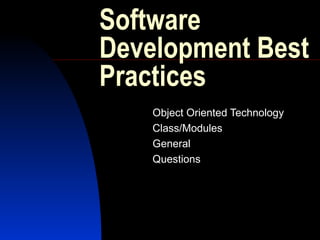
Software development best practices
- 1. Software Development Best Practices Object Oriented Technology Class/Modules General Questions
- 2. Object Oriented Technology Encapsulation Inheritance Abstraction Polymorphism
- 3. Encapsulation Public – Visible to all, Shared members Protected – Visible only through inheritance Default – Package level access Private – Visible only within the component Rule: Protect variables by methods, Limit and Control code access
- 4. Inheritance Apply “IS A” rule
- 5. Abstraction A way to segregate implementation from interface. Achieved by using interface and abstract class. Use abstract class if you know the common behaviour. User interface when implementation varies.
- 6. Polymorphism Behaviour vary by type Overloading – Object at compile time Overriding – Object at runtime Super type Method Argument Super type Variable Return Super type
- 7. Class/Module Loose Coupling – Interaction through Simple Interface High Cohesion – Reliability, Reusability, Reduced maintenance and modification costs. Name – NOUN Package – Should not contain irrelevant classes -cont.
- 8. Class/Modules Use appropriate access levels. Method – Self Explanatory. Use of Java bean standards.
- 9. General Use source control system. Use coding standards – Variable, Class, Method name, tabs, brackets. Delete unused code. Catch specific exception. Use understandable comments.
Notes de l'éditeur
- Coupling increases between two classes A and B if: A has an attribute that refers to (is of type) B . A calls on services of an object B . A has a method that references B (via return type or parameter). A is a subclass of (or implements) class B .